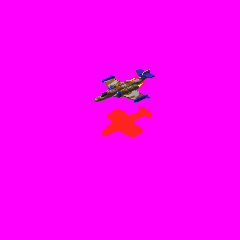Good stuff Hunter, well done
Here is some more info on the Avro CF-100, for those that are
interested:
The first requirements for an aircraft similar to the CF-100 were published by the Air Force as early as January of 1945. However, with the end of the war and a return to peace, the requirement for such an all weather fighter was temporarily put on the hold. By November of that same year, A.V. Roe Ltd. was contracted to design and construct and airframe that would eventually be called the CF-100.
After some development problems that plague any new fighter design, the first CF-100 was completed in late 1949. On January 17, 1950, taxi trials occurred and the first flight was just 2 days later, with Bill Waterton at the controls. This was the first of 692 models that were eventually produced. There were many variants, culminating in the CF-100 Mk 5, which was the ultimate rocket armed interceptor version. Many Mk 5's were later converted to electronic warfare birds. In this role the CF-100s simulated the enemy bombers they were designed to defend against. By simulating enemy aircraft, the CF-100's of 414 squadron helped to keep NORAD in a high state of preparedness to guard North America against Soviet air attack.
In many ways, the CF-100 provided Canada with a first rate aircraft. It had a good range and payload carrying ability but the CF-100 was not considered to be a great dog-fighter, when compared with the Sabre. However, in the all weather interceptor role, it was second to none. When compared to its American counterpart, the F-89 Scorpion, the CF-100 Canuck is considered to be superior in all aspects.
The last CF-100's were retired from Canadian service in 1981, some 29 years after the first aircraft joined the ranks of the RCAF. The CF-100 was designed and built by AVRO Canada. To this day it remains the only Canadian fighter that was designed, built and put into Canadian service with the Royal Canadian Air Force.
The Canuck also served in the Royal Belgium Air Force from 1957 to 1960. They purchased a small force of 53. These were replaced by the F-104 Starfighter in Belgium service. When Belgium retired its force, they scrapped them so fast that not one aircraft was preserved. In 1971, Canada sold a CF-100 to Belgium to put on display in Brussels, where it remains today.
The AVRO Arrow was to replace the CF-100 in its roll as defender of Canadian airspace. However, with the cancellation of the Arrow in 1959, the RCAF would be forced to buy American and eventually purchased the CF-101 Voodoo for the manned air defense of Canada.
The development, production, and operation of the CF-100 represents one of Canadian aviation's outstanding achievements. It remains the only Canadian designed and built combat aircraft to reach operational status and the "Canuck" played a critical role in this country's participation in the defence of North America and Europe during the first two decades of the Cold War.
Following the defeat of Hitler, Canada's and the western world's attention became focused on the new threat posed by the Soviet Union. To play its part in the defence of North America, Canada needed a long range, all-weather interceptor capable of confronting the only threat seen at that time, Soviet bombers travelling across the Arctic Ocean carrying nuclear weapons. In 1946 Avro Canada began design work on a two seat, twin engined jet fighter and the first CF-100 flew in January, 1950.
The "Canuck" became operational in 1953 and continued flying with the Royal Canadian Air Force, and later the Canadian Armed Forces, until 1981. Both its role and weaponry changed through the years as some squadrons of CF-100's were based in Europe as part of NATO and the aircraft's armament evolved from machine guns to rockets and guided missiles.
In its prime, the "Canuck" was known as a rugged, dependable aircraft. One of the best all-weather fighters available, it served Canada, NORAD, and NATO well.
The community of Nanton has a very special connection to the CF-100 through Bruce "Duke" Warren. Bruce and his identical twin brother Douglas were born in Nanton. They trained together in the BCATP and fought together flying Spitfires during the war and were both awarded the DFC.
Tragically, Bruce was killed in 1951 flying a CF-100 prototype. An investigation revealed a probable oxygen system failure.
Avro CF100 Specifications Engines: two Orenda 8's,
6355 lbs. thrust each
Wingspan: 52 ft.
Length: 52 feet 3 inches
Height: 14 ft. 6 inches
Maximum Weight: 33 000 pounds
Empty Weight: 23 000 pounds
Service Ceiling: 54 000ft.
Maximum Speed: 645 miles per hour
Range: 2000 miles
I've got links and pictures if anyone wants to learn more.




 :santa: :love2: :jump:
:santa: :love2: :jump: 


